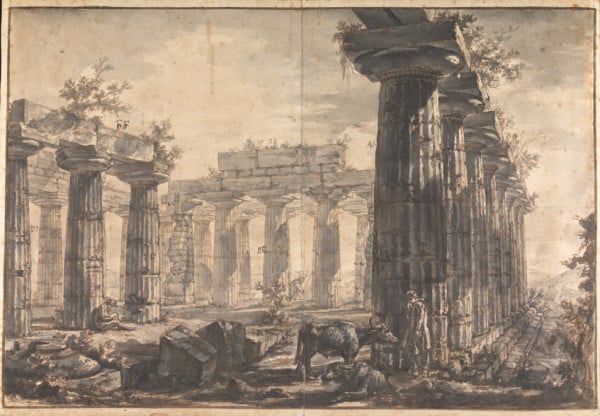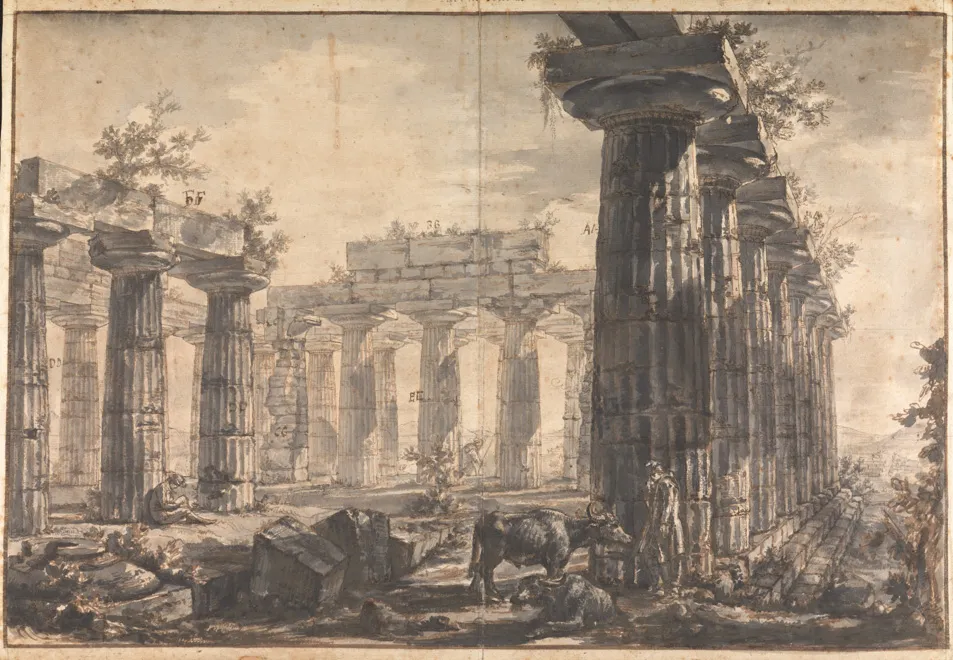
In 1777, Italian printmaker and architect Giovanni Battista Piranesi visited the ancient Greek city of Paestum on the Gulf of Salerno, creating a series of studies focusing on three Doric temples in the city. “Piranesi’s Paestum,” currently on view at the Cantor Arts Center, displays some of Piranesi’s rare preparatory drawings and sketches from the series. The exhibit is both a love letter to Doric architecture and a masterclass in perspective drawing, providing a glimpse into Paestum from – quite literally – Piranesi’s perspective.
Piranesi populates his architectural studies with portrayals of figures and animals, enlivening his environments with an organic quality. Likely from imagination, his portrayals of the figure show an incredible ability to visualize a setting and translate that setting into marks on the page.
For most of the drawings in the series, Piranesi employs largely the same techniques. Black and brown ink, pen and black chalk are spattered onto toned paper. The paper has a rich and varied texture, creased and stained with age, mirroring the crumbling remnants of Paestum.
Piranesi’s experimentation with perspective and multiple vanishing points is the key selling point of the series. Piranesi tends to place his vanishing points off-center to vary his compositions and provide a more dynamic view of his subject matter. This is perhaps best seen in “Interior of the ‘Temple of Neptune,’ Looking East,” wherein rows of two-tiered pillars plunge diagonally across the page and into the ink-wash background. The artist also employs atmospheric perspective as his structures recede into the background, which he indicates by using a lighter ink wash and more sparse chalk lines.
The way the exhibit is curated mirrors the structured composition of Piranesi’s studies. The Italian’s works are evenly spaced around the room, encircling the viewer, as if the viewer is a bystander in one of Piranesi’s compositions.
Similar to its counterpart “Artists at Work,” “Piranesi’s Paestum” places particular focus on Piranesi’s creative process. In a comparison of initial study and completed print, the curator places both iterations of “View of the Interior of the ‘Basilica,’ Looking West” side by side.
Despite being the same scene drawn by the same artist, the two drawings give off completely different vibes. In the preparatory drawing, loose ink splashes carve clouds out of negative space, whereas in the print they are sharply defined. The sketch feels more warm and organic; ink strokes loosely suggest the presence of shadows. In the print, shadows are more dark and ominous, rendered via hatch lines.
Likewise, “Interior of the ‘Basilica,’ Looking Northeast” clearly shows the artistic process of revision. Lines of red chalk shadow the figures in the scene, suggesting Piranesi’s exploration of various poses.
“Piranesi’s Paestum” explores the historical significance of Paestum’s colossal Doric temples and how Piranesi explored these landmarks through his illustrations. Piranesi’s dynamic compositions and command of perspective draw us out of the gallery space and into Greece of antiquity.
“Piranesi’s Paestum” is on view at the Cantor Arts Center until Jan. 4, 2016.
Contact Eric Huang at eyhuang ‘at’ stanford.edu.
